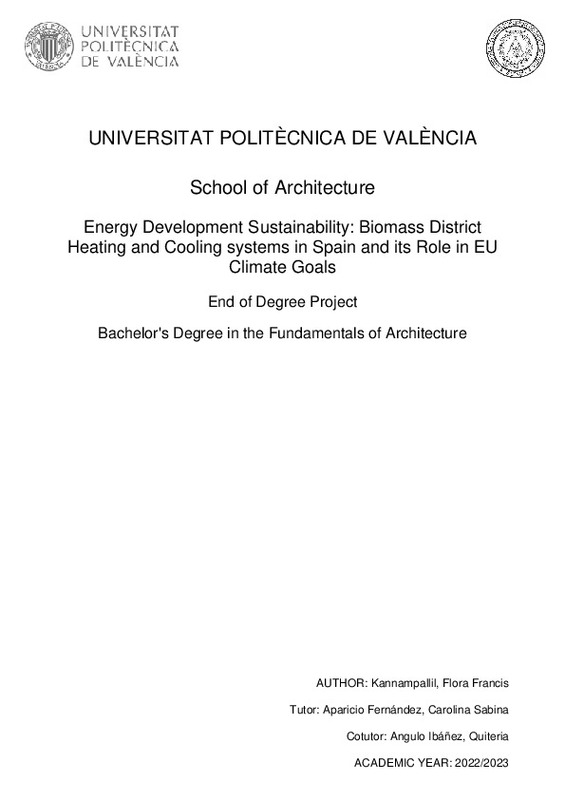|
[ES] Este documento investiga los sistemas de calefacción y refrigeración urbana (DHC) en España con un enfoque en ejemplos alimentados con biomasa y cómo ayudan a lograr los objetivos energéticos de la UE en 2030, analizando ...[+]
[ES] Este documento investiga los sistemas de calefacción y refrigeración urbana (DHC) en España con un enfoque en ejemplos alimentados con biomasa y cómo ayudan a lograr los objetivos energéticos de la UE en 2030, analizando su papel para lograr la sostenibilidad del desarrollo energético y lograr el cambio climático de la UE. objetivos para 2030.
La Unión Europea se había fijado como objetivo para 2020 reducir las emisiones de gases de efecto invernadero (GEI) en un 20 %, mejorar la eficiencia energética en un 20 % y aumentar la energía renovable compartida en un 20 %. Los objetivos energéticos para 2020 se alcanzaron con un consumo final bruto de energías renovables del 22%, representando España individualmente el 21,2%. El camino de la UE hacia la neutralidad climática ha establecido hitos para 2030 y 2050. NREAP afirma que alrededor de un tercio del consumo de energía (32,5 %) corresponde a la calefacción y refrigeración, mientras que los sistemas derivados de biomasa solo representan el 11 % del sistema de calefacción y refrigeración en Europa. En España, nueve de cada diez de las nuevas instalaciones utilizan esta fuente de energía.
Un análisis detallado de cinco sistemas de calefacción y refrigeración urbana con biomasa españoles muestran una mejor eficiencia en comparación con cualquier otra solución de producción de energía térmica con posibilidad de incorporar energías renovables a gran escala analizando los resultados para mostrar cómo ayudan a alcanzar el objetivo climático para 2030.
[-]
[EN] This thesis investigates the role of biomass-powered District Heating and Cooling (DHC)
systems in Spain and their contribution towards achieving the energy goals set by the
European Union for 2030. With a focus on ...[+]
[EN] This thesis investigates the role of biomass-powered District Heating and Cooling (DHC)
systems in Spain and their contribution towards achieving the energy goals set by the
European Union for 2030. With a focus on biomass as an energy source, this study examines
how these systems help promote energy development sustainability and support the EU's
climate objectives.
The European Union had set a target for 2020 to lower greenhouse gas (GHG) emissions by
20%, improve energy efficiency by 20% and increase shared renewable energy by 20%. The
energy goals for 2020 were achieved with a 22% gross final renewable energy consumption
with Spain individually accounting for 21.2%. EU’s path to climate neutrality has set milestones
for 2030 and 2050. NREAP states that about a third of the energy consumption (32.5%)
pertains to heating and cooling wherein Biomass-derived systems only represent 11% of the
heating and cooling system in Europe. In Spain, nine out of ten of the new installations use
this energy source.
A detailed analysis of five Spanish biomass district heating and cooling systems show better
efficiency compared with any other thermal energy production solution with the possibility of
incorporating large-scale renewable energies analysing the results to show how they help to
achieve the climate goal for 2030.
[-]
|







